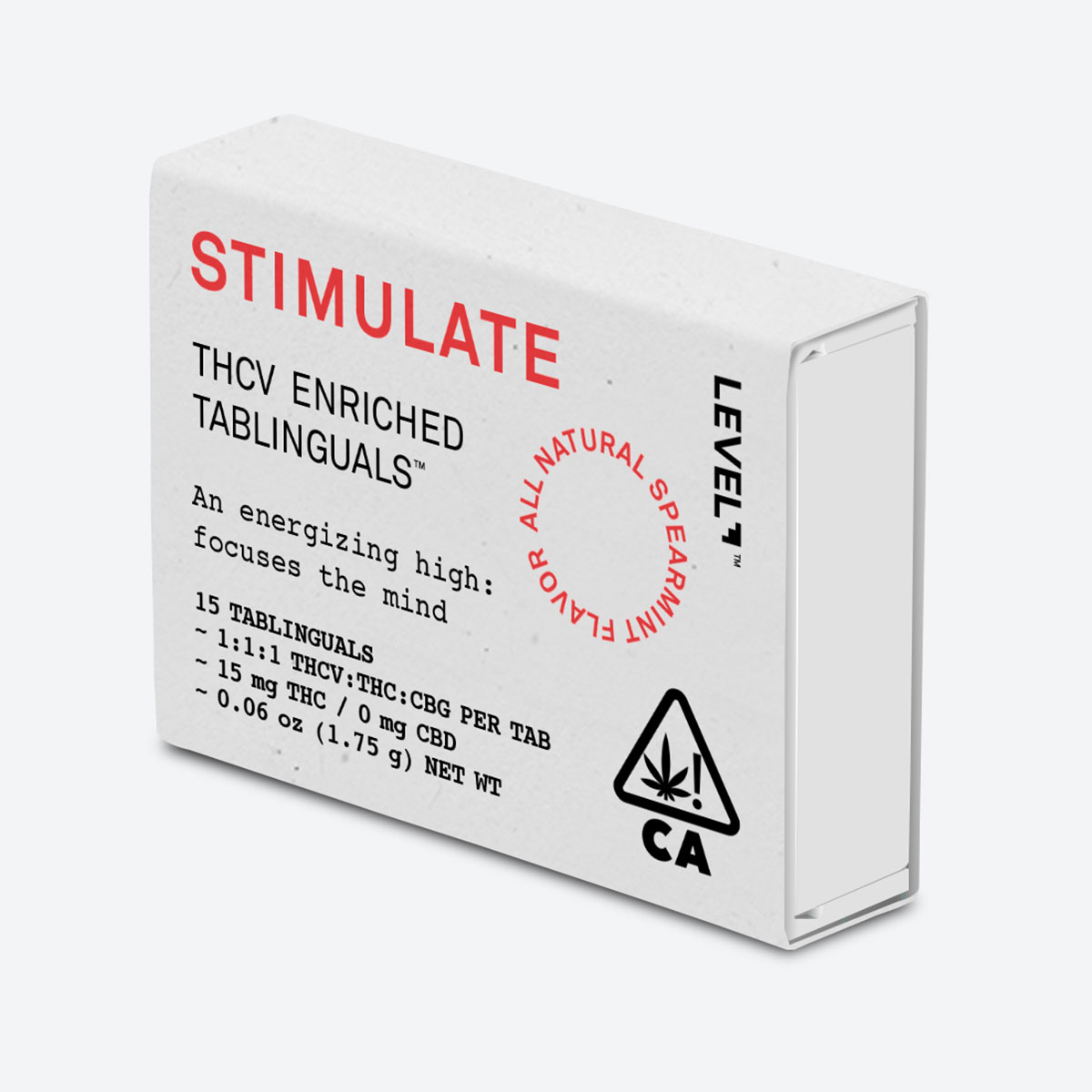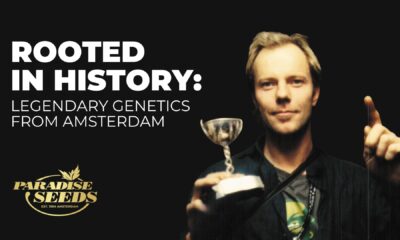Top Takeaways
- There’s a molecule in weed being dubbed diet weed—“THC-V”
- Some evidence exists that THCV gets you high without the munchies
- This study supports that finding, but in a weak way
- More research is needed
Read below as Leafly science writer Nick Jikomes, PhD digs into the latest hype study.
THCV is a minor cannabinoid that’s acquiring a reputation as “diet weed.” You can find it described this way online based on historical studies linking it to appetite suppression. Excitement has spiked again with the conclusion of a yet-to-be-published, privately-funded, double-blind, human study. The results have been reported like this: “THCV increases energy and motivation without marijuana’s ‘munchies’ effect.”
What, exactly, did this study find? Are the results robust, and how do they fit into the wider picture of what we know about the biological effects of THCV? To understand, let’s review what’s been shown historically, using that to understand the latest findings.

CB1 Receptors, cannabinoids & eating
It has long been known that THC stimulates appetite in the short-term. “The munchies’” are well-known to cannabis consumers and there’s considerable research demonstrating THC’s ability to stimulate appetite. This effect comes from the CB1 receptor of the endocannabinoid system. Stimulating CB1 reliably elicits feeding. This can be achieved by exogenous plant cannabinoids like THC, endogenous cannabinoids like anandamide, or synthetic CB1 activators used in scientific research. In other words, there is a general tendency for CB1 activators to induce feeding (“hyperphagia” is the technical term).
Preventing CB1 receptor activation tends to have the opposite effect. If you engineer animals that lack CB1 receptors entirely, they are lean and resistant to diet-induced obesity. If you block the CB1 receptor with drugs, this tends to reduce appetite (“hypophagia”)—animals eat less.
The ability of THC and other CB1 activators to induce feeding is dose-dependent. In general, lower doses induce less feeding, higher doses more (up to a point). An interesting wrinkle in the equation between CB1 receptor stimulation and feeding is that drugs like THC don’t merely impact total feeding levels, but patterns of food intake over time. For example, recent work has shown that THC vapor induces an acute (short-term) increase in feeding in rodents, which is then followed by a compensatory reduction in food intake over longer time periods. The net effect is that there’s no overall weight gain, which may explain why human surveys tend to find a negative correlation between cannabis consumption and obesity.
human surveys tend to find a negative correlation between cannabis consumption and obesity
Bottom line: CB1 receptors are critical for appetite, and any drug that affects CB1 receptors is likely to affect appetite. As I’ve explained in more detail elsewhere, CB1 receptors are located throughout the body, influencing many aspects of metabolism.
How does THCV affect the CB1 receptor?
- If it activates CB1, we would expect THCV to induce a short-term increase in feeding.
- If it blocks CB1, we would expect a short-term decrease in feeding.
- The answer: it can do both.
There is evidence that, at low doses, THCV behaves as a CB1 receptor antagonist, blocking the receptor. At higher doses, it can behave as an agonist, activating CB1. We would therefore expect relatively low doses of THCV to suppress appetite in the short-term, and higher doses to enhance it.
What happens when you give relatively low doses of THCV to animals? Researchers have shown that pure THCV has been shown to induce hypophagia (eating less) and weight loss in rodents, similar to synthetic CB1 blockers. No surprise there–if THCV blocks CB1 receptors, that’s what we expect. An interesting twist in that study: when the same dose of THCV was applied in the form of a whole-plant extract, instead of pure THCV, the effect went away. In other words, the THCV extract did not produce a significant change in body weight or food consumption. Why? One possibility is the presence of small amounts of THC in whole-plant extracts. Because both THC and THCV interact with CB1 receptors, they “compete” with each other for access to the receptor. As a result, the relative ratio of THC and THCV becomes important for determining the net effect.
Related
Can THCV really curb the munchies?
What happens when you give THCV to humans? In one historical pilot study, researchers gave small doses of THCV to patients with type II diabetes (5 mg, twice daily for 13 weeks). Compared to placebo, THCV induced a statistically significant effect on fasting glucose levels and pancreatic β-cell function. That result is relevant to the treatment of diabetes and related effects on insulin sensitivity have been observed in mice. However, it did not have a significant impact on appetite or body weight. A major caveat of that study is that it was small–only 10-14 patients were in each experimental group, each on a different combination of prescription diabetes drugs.
Shop highly rated dispensaries near you
Showing you dispensaries near
In summary, THCV has been shown to block CB1 receptors at certain doses and animal research has observed an appetite-suppressing effect. However, the small human trial described above failed to show such an effect. It’s possible an effect would be seen with a different dose or in a metabolically healthy population. Both dose and the presence or absence of other drugs are important variables to consider, as we’ll see below.
The latest human research on THCV: Does it show a suppression of hunger?
Phylos Biosciences helped fund a double-blind, placebo-controlled crossover trial thatgave 78 adults different combinations of placebo, THC, and/or THCV for three days at a time. Patients ate the drugs in the form of gummies. “Crossover trial” means that each group of participants got each combination of drugs on different weeks. The drug combinations used:
- Placebo (no cannabinoids)
- THC only (5 mg)
- THC (3.4 mg) + THCV (5 mg)
Notice some details:
- There is no THCV-only condition
- The combination THC + THCV condition involves a lower dose of THC (3.4 mg) compared to the THC-only condition (5 mg)
- The THCV dose used (5 mg, once per day) was less than what was used in the other study we looked at above, which saw no effect on appetite (5 mg, twice daily).
Related
Your guide to the hottest hemp cannabinoids
Let’s first describe the headline result. After that, we’ll critically evaluate the results and whether we can take them to the bank. From the study abstract:
“Both THC and THCV + THC increased subjective energy, activity, exercise performance, and well-being compared to placebo… with the THC-only intervention increasing hunger in full doses. THCV ameliorates the increase in hunger associated with THC consumption.”
What they’re reporting here is that 5 mg of THC increased hunger levels. No surprise there. This dose of THC has been shown to stimulate appetite before, which is what we’d expect based on a wealth of literature. When they say, “THCV ameliorates the increase in hunger associated with THC,” that means that in their combined THC + THCV condition, people got less munchies than normal.
The analyzed data are not available in the published abstract and methods. Below are some numbers from a recent press release (the full study has not been published yet, to my knowledge). Note that the THCV gummy they used comes from a strain marketed as, “Get Sh!t Done™” (GSD):
- 20% more participants felt energized after consuming the GSD gummy compared to placebo.
- 40% more participants reported enjoying their daily activities after consuming the GSD gummy compared to placebo.
- Participants who consumed the THC-only gummy reported a 50% increase in hunger when taking full doses.
- Participants who consumed the GSD gummy did not report a statistically significant increase in hunger compared to placebo.
- Participants who consumed the THC-only gummy reported feeling fatigue three times more than the GSD group.
- Participants who consumed the GSD gummy reported significantly less fatigue than placebo.
- Both GSD and THC-only gummies increased activity, exercise performance, motivation, and well-being compared to placebo.
- There was no THCV-only option

Notice how the team describes the results. More participants are said to have felt energized and enjoyed their daily activities With the GSD (THCV) gummy compared to placebo. Remember: there is no THCV-only condition. Finding that people who consumed the GSD (THCV) gummy reported more energy and enjoyment of activities does not mean that the effect came from THCV—it came from THCV together with THC.
Similarly, when they say, “Participants who consumed the THC-only gummy reported feeling fatigue three times more than the GSD group,” what this really means is that more fatigue was reported in response to 5 mg of THC compared to 6.5 mg of THCV together with 3.4 mg THC.
The hunger result must be similarly parsed: “Participants who consumed the THC-only gummy reported a 50% increase in hunger when taking full doses. Participants who consumed the GSD gummy did not report a statistically significant increase in hunger compared to placebo.”
That translates to: those who consumed 5 mg of THC reported a 50% increase in hunger, while those who consumed only 3.4 mg THC together with 6.5 mg of THCV reported no hunger increase compared to placebo.
Because there is no THCV-only condition and two different doses of THC were used in the THC-only vs. THC + THCV condition, the results cannot be clearly interpreted.
Bottom line: We need to isolate THC-V’s effects from THC
We know that THC’s psychoactive effects, including on appetite, are dose-dependent. Therefore, the differences they report in energy levels, hunger, and fatigue can all be explained by the difference in THC dose. You would expect a lower dose of THC (3.4 mg) to induce a different level of hunger and energy/fatigue than a higher dose (5 mg). It would be surprising if it didn’t.
These results would have been more readily interpretable if they had kept the THC dose at 5 mg in both groups, and added a THCV-only group as a further control. Assuming the results are replicable, we cannot know whether the differences they saw between groups had anything to do with the presence of THCV, or were entirely due to the two doses of THC used.
There are interesting hints in the literature that THCV may have important effects of metabolism, including appetite-suppressing effects in rodents. But before we conclude that “diet weed” has been discovered, more diligent research is in order.









































